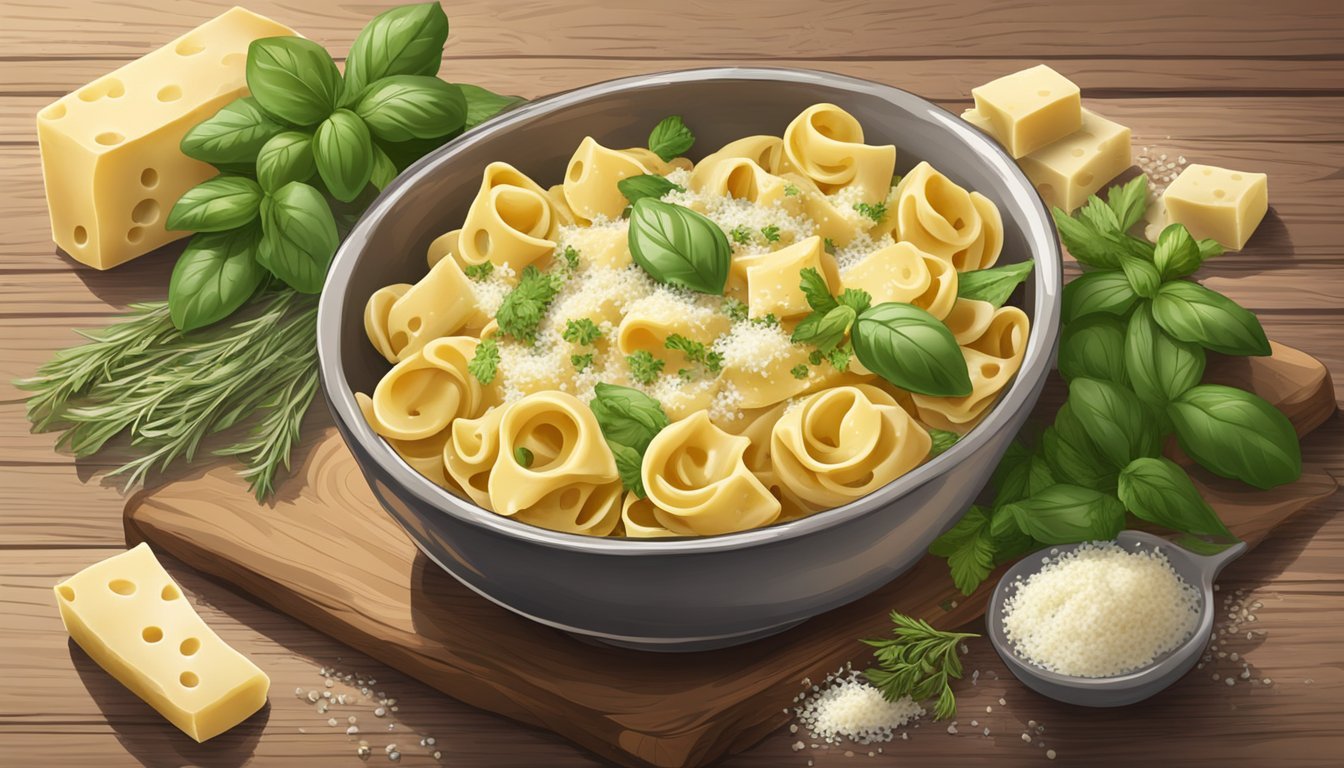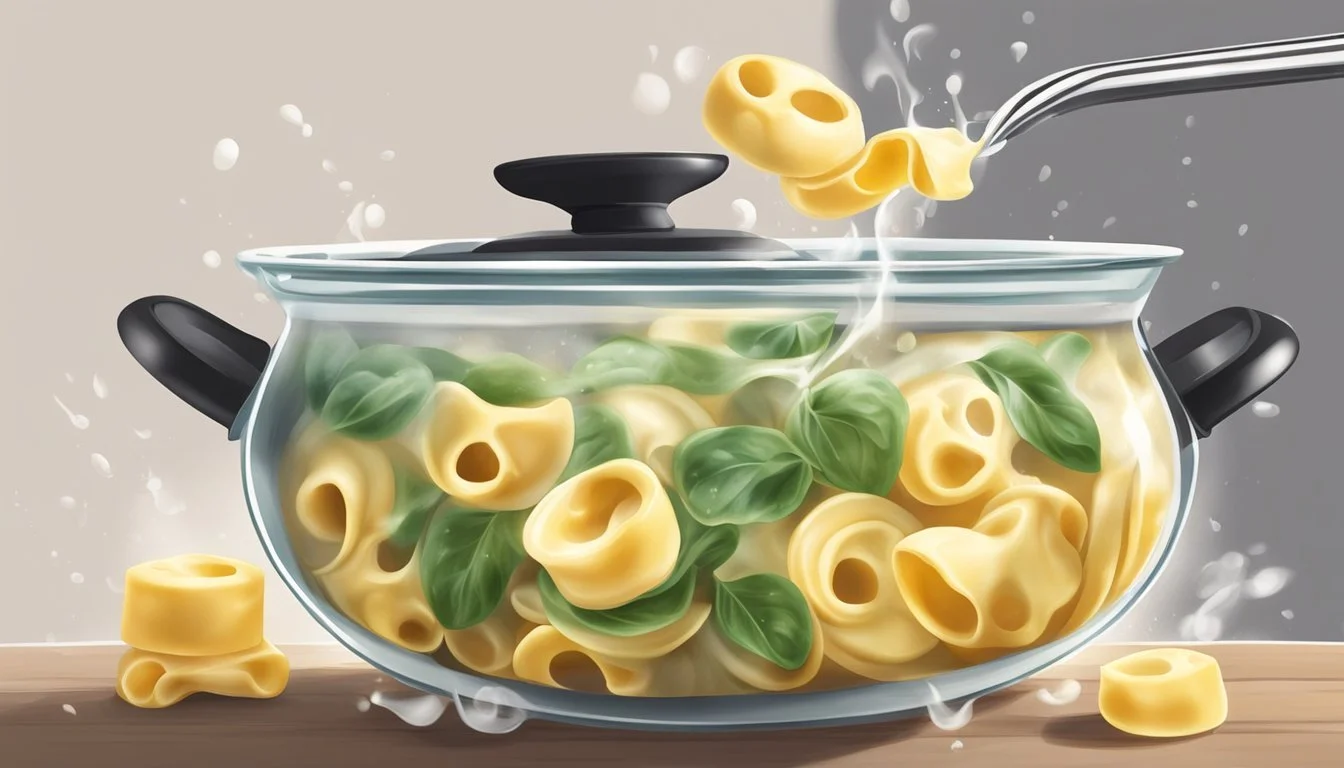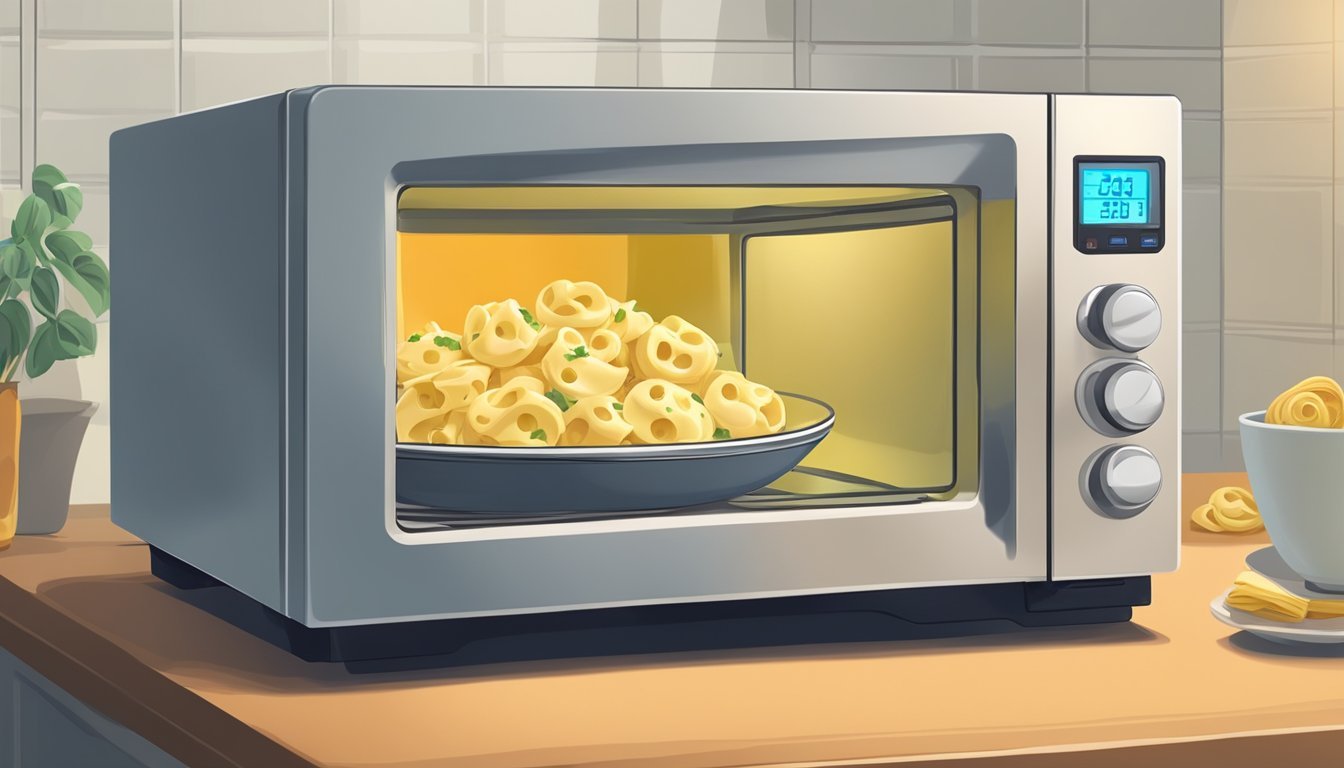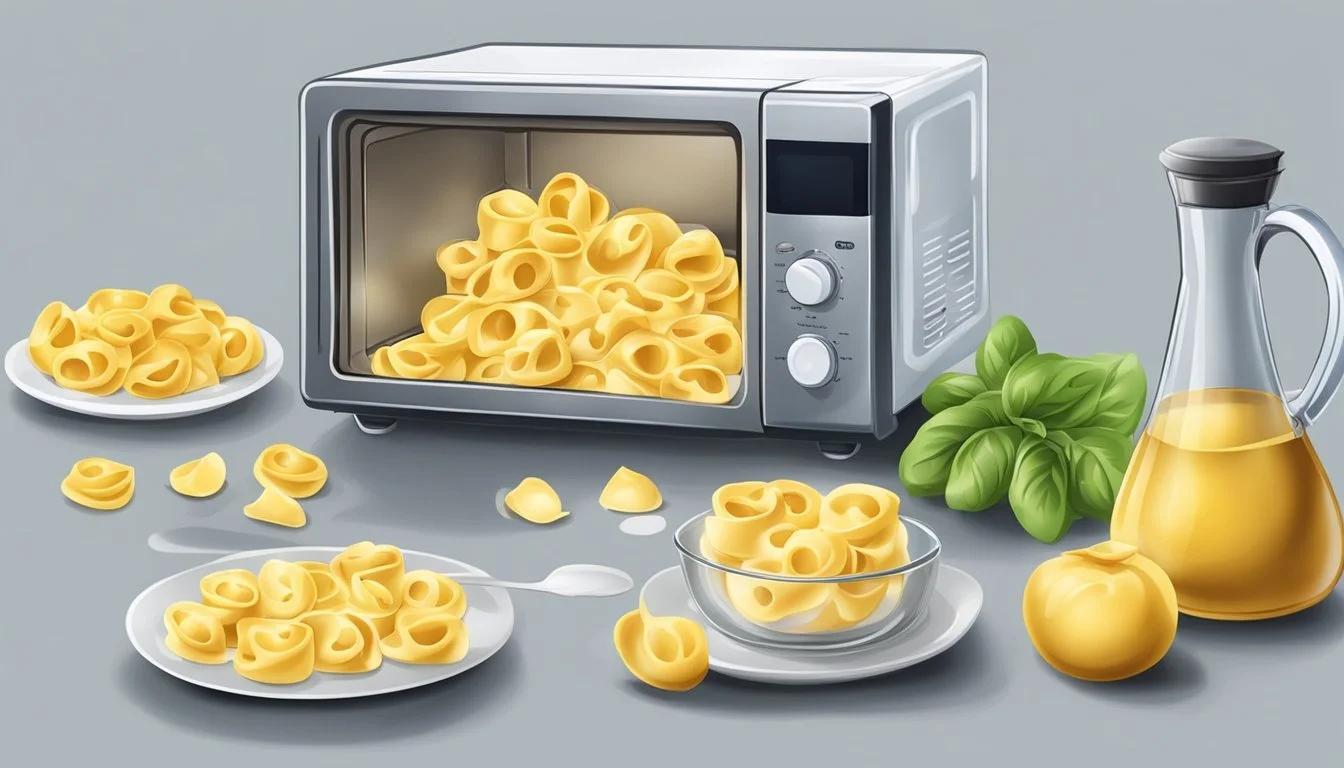How to Reheat Four Cheese Tortellini for Perfect Taste
Reheating four cheese tortellini can be a delightful experience when done correctly, ensuring the pasta retains its creamy texture and rich flavors. Whether you choose the oven, microwave, or skillet method, each approach provides an effective way to bring your tortellini back to life. For those who prefer a moist reheating method, adding a small amount of sauce or broth can keep the tortellini tender and savory.
Using the oven provides a steady and even reheating process that prevents overcooking. Preheat your oven to 350°F and cover the dish with aluminum foil to trap moisture, keeping the tortellini from drying out. Alternatively, using a skillet with a bit of olive oil or butter ensures each piece of pasta is evenly heated and slightly crispy on the outside.
The microwave is a quick solution for a fast meal. Place the tortellini in a microwave-safe container, add a splash of water or broth, cover it, and heat on high for 1-2 minutes. Stir halfway through for even heating. Each technique ensures the four cheese tortellini is ready to enjoy with its mouthwatering blend of cheeses intact.
Understanding Four Cheese Tortellini
Four Cheese Tortellini is a delightful pasta dish known for its rich blend of cheeses encased in tender pasta. This section delves into the composition of this classic dish, highlighting the key cheeses utilized to achieve its distinct flavor profile.
Components of Four Cheese Tortellini
Four Cheese Tortellini is composed of a pasta shell and a unique four-cheese filling. The pasta is typically made from durum wheat flour and eggs, resulting in a firm yet pliable dough that holds up well during cooking. Filled tortellini are crafted by pressing and sealing the dough around a mixture of cheeses, creating bite-sized packets of flavor.
The filling is the centerpiece of Four Cheese Tortellini. It combines different cheeses to provide a balance of creamy, tangy, and savory notes. These tortellini are often paired with various sauces, such as marinara, Alfredo, or a simple butter and herb sauce, that complement the cheesy filling.
Types of Cheese Used
Four Cheese Tortellini traditionally includes Parmesan, Ricotta, Mozzarella, and Romano cheeses. Each cheese contributes distinct characteristics to the overall flavor:
Parmesan Cheese: Known for its sharp and nutty flavor, Parmesan adds a strong, savory depth.
Ricotta Cheese: This soft, creamy cheese offers a mild and slightly sweet taste, lending a smooth texture to the filling.
Mozzarella Cheese: Mozzarella brings a stretchy, melty quality and a delicate milkiness that balances the sharper cheeses.
Romano Cheese: Romano, often saltier and tangier than Parmesan, enhances the overall taste with its bold, robust flavor.
These cheeses are finely grated and blended together, creating a rich and satisfying filling that is quintessential to Four Cheese Tortellini. Properly selecting and combining these cheeses is crucial for achieving the desired taste and texture.
Preparing Tortellini for Reheating
To ensure your leftover tortellini tastes fresh, proper preparation is essential.
Storing Leftover Tortellini
Once cooked, refrigerate any leftover tortellini within 2 hours. Use airtight containers to maintain freshness. If freezing, place tortellini in a freezer-safe bag, removing excess air before sealing. Label the container with the date for reference.
Preserving Moisture
When ready to reheat, prevent the tortellini from drying out. Drizzle with a small amount of olive oil or a few drops of water. This helps retain moisture during the reheating process and keeps the pasta from becoming too dry.
Prepping for Different Reheating Methods
Depending on your preferred method, preparation can vary:
Microwave: Place tortellini in a microwave-safe dish with a lid, adding a tablespoon of water if necessary.
Stovetop: Use a non-stick skillet, adding a drizzle of olive oil or a small pat of butter to prevent sticking.
Oven: Preheat the oven to 350°F (175°C). Place tortellini in an oven-safe dish, cover with foil to retain moisture.
Tips for Best Results
Refrigerator Storage: Store tortellini in the refrigerator for up to 3 days.
Freezing: For longer storage, freeze tortellini for up to 3 months.
Toss with Sauce: Pre-tossing with sauce helps maintain flavor and moisture during reheating.
Reheating Options Overview
There are several effective methods to reheat four cheese tortellini, each with its own set of advantages. These include using the oven, microwave, stovetop, and air fryer. Choosing the best method depends on factors such as time, convenience, and the desired texture.
Determining the Best Method
Oven: Reheating tortellini in the oven ensures even heating and preserves texture. Preheat the oven to 350°F (175°C). Place the tortellini in an oven-safe dish, add a small amount of water or broth to prevent drying out, and cover with foil. Bake for 10-15 minutes until heated through. This method is ideal for maintaining the dish's original quality.
Microwave: For quick reheating, the microwave is a practical option. Arrange the tortellini in a microwave-safe dish, add a splash of water, and cover with a microwave-safe lid or plastic wrap. Heat on medium power for 1-2 minutes, stirring midway to ensure even heating. Microwave reheating is perfect for those short on time.
Stovetop: Using the stovetop allows for excellent control over the reheating process. Place the tortellini in a skillet or saucepan, adding a bit of water or sauce. Heat over medium-low heat, stirring occasionally, until warmed through. This method helps keep the pasta from becoming mushy or overcooked.
Air Fryer: The air fryer provides a unique option for crisp reheating. Preheat the air fryer to 350°F (175°C). Add the tortellini in a single layer and heat for 5-7 minutes, shaking the basket halfway through. The air fryer method results in a slightly crisp exterior, offering a different texture experience.
Oven Reheating Method
Reheating tortellini in the oven yields consistent and flavorful results. This approach ensures even heating and prevents the pasta from becoming soggy.
Preparing the Oven and Dish
Begin by preheating the oven to 350°F (175°C). This temperature is ideal for warming the tortellini without overcooking it.
Next, select an oven-safe baking dish or casserole dish. Transfer the tortellini from the storage container to the dish. If the pasta appears dry, add a splash of water or broth to maintain moisture. Cover the dish with aluminum foil to keep the tortellini from drying out during reheating.
Oven Reheating Steps
Once the oven reaches the desired temperature, place the covered baking dish inside. Allow the tortellini to reheat for 10-15 minutes.
Check the pasta occasionally to ensure it heats evenly. Stirring halfway through can help distribute the heat. If reheating at a higher temperature of 400°F (200°C), reduce the time to 5-10 minutes.
Once heated through, remove the dish from the oven. Carefully lift the aluminum foil to avoid steam. Your baked tortellini is now ready to serve.
Stovetop Reheating Technique
Using the stovetop to reheat four cheese tortellini is efficient and effective. This method ensures even heating and maintains the delicious texture of the pasta.
Using the Skillet Effectively
To start, heat a non-stick skillet over medium heat. Add a small splash of water, broth, or a drizzle of olive oil to the skillet to prevent sticking. Once the liquid or oil is shimmering, add the tortellini, ensuring they are spread out evenly.
As the tortellini heats, stir gently to coat each piece with the oil and prevent it from sticking to the skillet. This ensures that the tortellini is heated uniformly. Cover the skillet with a lid for a few minutes to trap the steam, which helps to heat the pasta thoroughly without drying it out.
Check the tortellini occasionally to prevent overcooking. It usually takes about 5-7 minutes to reheat on the stovetop. Once heated through, remove from the heat and serve immediately.
Maintaining Tortellini Integrity
Maintaining the integrity of the four cheese tortellini while reheating involves a few key techniques. First, avoid overcrowding the skillet. This allows each piece to heat evenly.
Gentle stirring is crucial. Use a spatula or wooden spoon to carefully move the tortellini around the skillet. This prevents the tortellini from breaking apart and keeps the cheese filling intact.
If reheating tortellini with sauce, add a small amount of sauce or a splash of water to the skillet. This will help maintain moisture and avoid sticking.
Finish by heating on low and stirring occasionally until the tortellini is warmed through. This method preserves the texture and flavor of the cheese-filled pasta.
Microwave Reheating Instructions
Reheating tortellini in the microwave can be quick and effective if done correctly. Properly using microwave-safe containers and maintaining moisture are key factors to ensure the tortellini remains tender and delicious.
Microwave Safety
When reheating tortellini, always use a microwave-safe container. Glass, ceramic, and certain approved plastics are suitable choices. These materials prevent chemicals from leaching into your food and ensure even heating.
Avoid using metal or containers with metallic trim as these can cause sparks and fires. Additionally, cover the container with a microwave-safe lid or plastic wrap, leaving a small vent for steam to escape. This prevents pressure build-up and potential spills.
Finally, read the manufacturer's instructions for your microwave to understand the power settings and recommended usage to avoid mishaps.
Step-by-Step Microwave Reheating
Prepare the Tortellini: Place the tortellini in a microwave-safe container. Add a splash of water or broth to keep the pasta moist during reheating.
Cover Properly: Use a microwave-safe lid or plastic wrap. Ensure there are small holes or a vent to allow steam to escape, preventing a build-up of pressure.
Initial Heating: Set the microwave to medium power. Heat the tortellini for one minute.
Stir and Check: After the initial heating, stir the tortellini gently to distribute the heat evenly. Check the temperature to see if more heating is needed.
Continue Heating: If required, continue heating in 30-second intervals, stirring after each round until the tortellini is thoroughly heated.
These steps help preserve the texture and flavor of the tortellini, ensuring it does not become tough or rubbery.
Alternative Reheating Methods
Reheating four cheese tortellini can be done using several kitchen appliances for a convenient and tasty result. Each method has its own unique advantages. Below are some alternative ways to achieve delicious reheated tortellini.
Using an Air Fryer
The air fryer is an excellent method for getting a crispy texture on your tortellini. Start by preheating the air fryer to 350°F. Lightly spray the tortellini with oil to prevent sticking and enhance browning. Place them in the air fryer basket, ensuring they are in a single layer to cook evenly.
Cook for 3-5 minutes, shaking the basket halfway through. This ensures the tortellini heats evenly and crisps up nicely. If you prefer a softer texture, reduce the cooking time slightly and cover the tortellini with a small amount of sauce before reheating.
Other Non-traditional Methods
Microwaving is a quick option. Place the tortellini in a microwave-safe container and add a splash of water or broth to keep it from drying out. Heat on high for 1-2 minutes, stirring halfway through for even reheating.
Another method is using a frying pan. Add a few tablespoons of water and a tight lid. Heat the tortellini on medium heat, stirring occasionally until warmed through. This method keeps the pasta moist and infuses the sauce with a bit more flavor.
Both methods are effective; the choice depends on personal preference and the available time.
Serving Reheated Tortellini
Reheated tortellini can be a delicious meal when paired with the right side dishes and enhanced with finishing touches for added flavor.
Pairing With the Right Side Dishes
Garlic bread is a classic companion to tortellini, adding a crunchy texture that contrasts perfectly with the soft pasta. A crisp green salad with a light vinaigrette can add freshness to the meal, balancing the richness of the four cheese tortellini.
Steamed vegetables such as broccoli or asparagus provide a healthy and colorful addition, making the meal more fulfilling. Fresh basil scattered over the tortellini adds a burst of flavor and enhances the dish's presentation.
Finishing Touches for Flavor
A sprinkle of Parmesan cheese can elevate the flavor profile significantly. Freshly grated Parmesan adds a sharp, nutty taste that complements the creamy cheese filling. Drizzle a bit of olive oil over the tortellini for a smooth, rich finish.
For an added layer of flavor, garnish with fresh basil leaves. If you prefer a bit of spice, a dash of red pepper flakes can bring heat to the dish. Remember to mix the tortellini gently to coat each piece evenly with the sauce and toppings before serving.
Safety and Storage Tips
To ensure that reheated four cheese tortellini remains safe and delicious, it's essential to follow proper storage and reheating practices. Key considerations include how to store leftovers in the refrigerator, and the correct methods for freezing and thawing.
Storing Leftover Tortellini
Leftover tortellini should be refrigerated promptly to minimize the risk of bacterial growth. Place the tortellini in airtight containers to keep it fresh and prevent contamination. It is advisable to store the pasta in the fridge within two hours of cooking. For best results, consume refrigerated tortellini within 3-5 days.
Labeling the container with the date can help track its shelf life. Properly sealed, the tortellini maintains its flavor and texture, ensuring a tasty reheated meal.
Freezing and Thawing Practices
Freezing extends the shelf life of tortellini when done correctly. To freeze tortellini, place it in freezer-safe bags or containers, removing as much air as possible. This prevents freezer burn and preserves quality. Label the containers with the date to keep track of storage time.
Thawing frozen tortellini safely is crucial to maintaining its texture and taste. The best method is to transfer it from the freezer to the refrigerator overnight. Avoid thawing at room temperature to minimize the risk of bacterial growth. For quicker results, tortellini can also be reheated directly from frozen using methods such as simmering in sauce or baking in a preheated oven.
Tortellini Variations and Additions
There are numerous ways to enhance four cheese tortellini with different ingredients and flavors. From incorporating a variety of vegetables and proteins to blending in international flavors, the possibilities are plentiful.
Customizing Your Tortellini
Adding vegetables and proteins can elevate the flavor of four cheese tortellini. Mushrooms and spinach are popular vegetarian choices that complement the rich cheese filling. Sautéed mushrooms bring an earthy depth, while spinach adds a fresh, slightly bitter taste.
For meat lovers, incorporating grilled chicken or beef can make the dish heartier. Grilling or sautéing the meat before combining it with the tortellini ensures it stays tender and flavorful.
Sauces also play a critical role in customization. Pesto and marinara sauce are classic options. Pesto offers a nutty and herby dimension, whereas marinara sauce brings a tangy and robust flavor. Mixing pasta with these sauces can create diverse taste profiles.
Incorporating Different Cuisines
Incorporating elements from various cuisines can give a unique twist to four cheese tortellini. For an Italian twist, integrate marinara sauce with fresh basil and a sprinkle of Parmesan cheese.
Exploring flavors from other cuisines can also yield exciting results. For a Mexican-inspired dish, consider adding spicy chorizo and a light cream sauce spiked with cilantro and lime juice.
An Asian-inspired version could include stir-fried vegetables like snap peas and shiitake mushrooms, finished with a light soy-ginger sauce. This blend introduces umami and a hint of sweetness, making each bite distinct and flavorful.
Combining these variations ensures that four cheese tortellini remains a versatile and delightful dish suitable for various palates and preferences.









